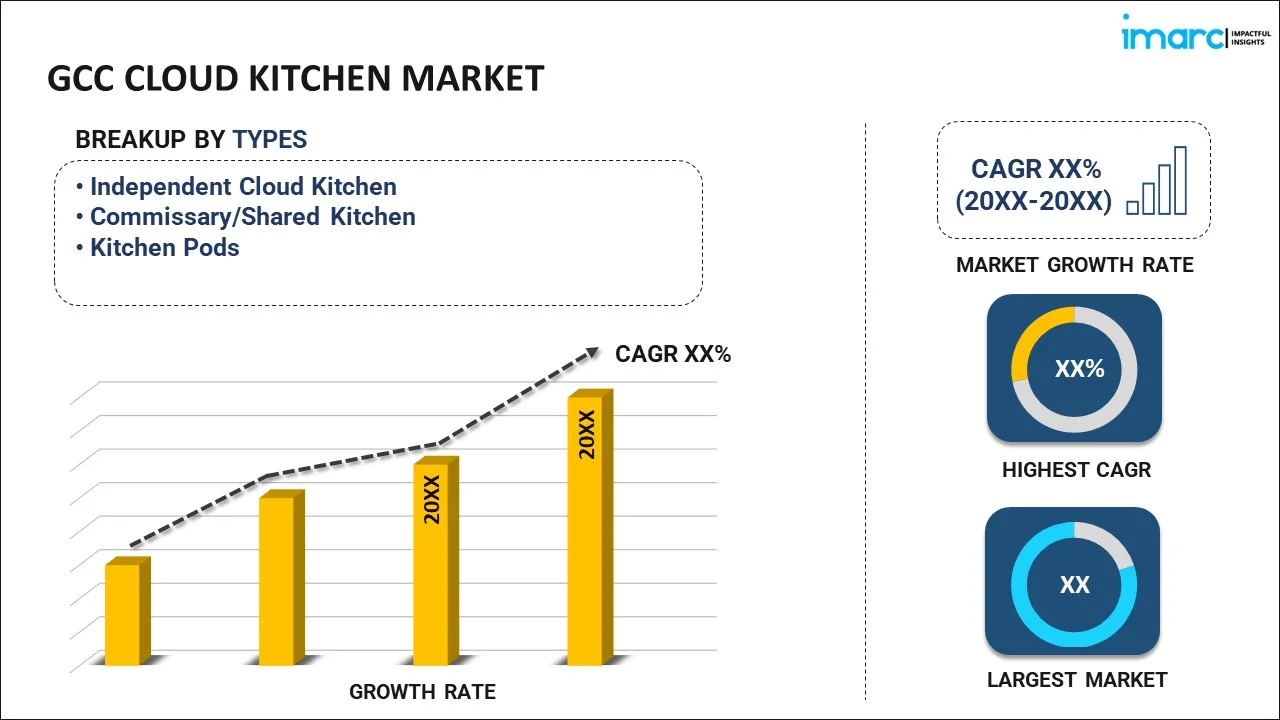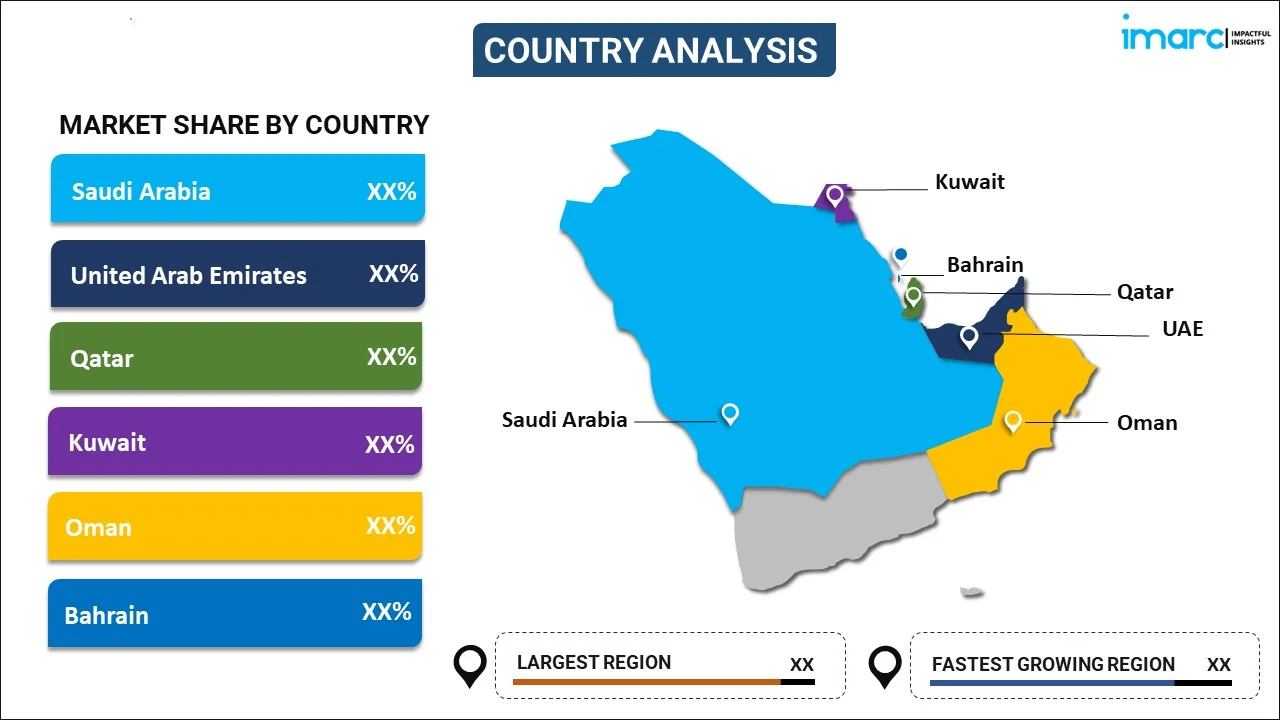
GCC Cloud Kitchen Market Report by Type (Independent Cloud Kitchen, Commissary/Shared Kitchen, Kitchen Pods), Product Type (Burger and Sandwich, Pizza and Pasta, Chicken, Seafood, Mexican and Asian Food, and Others), Nature (Franchised, Standalone), and Country 2025-2033
Market Overview:
The GCC cloud kitchen market size reached USD 2.0 Billion in 2024. Looking forward, IMARC Group expects the market to reach USD 6.6 Billion by 2033, exhibiting a growth rate (CAGR) of 13.7% during 2025-2033. The changing consumer preferences, cost-efficiency offered by the product, the rise of food delivery apps, growing digital transformation of food services, optimized resource utilization, and the escalating adaptation to market trends represent some of the key factors driving the market.
|
Report Attribute
|
Key Statistics
|
|---|---|
|
Base Year
|
2024
|
|
Forecast Years
|
2025-2033
|
|
Historical Years
|
2019-2024
|
|
Market Size in 2024
|
USD 2.0 Billion |
|
Market Forecast in 2033
|
USD 6.6 Billion |
| Market Growth Rate 2025-2033 | 13.7% |
A cloud kitchen, a virtual kitchen, a ghost kitchen, or a dark kitchen is a modern and innovative approach to the food service industry. Unlike traditional restaurants that serve dine-in customers, a cloud kitchen operates solely to fulfill online food orders for delivery or takeout. At the heart of a cloud kitchen is its digital presence. These kitchens don't have a physical dining space; instead, they leverage online platforms, mobile apps, and food delivery services to connect with customers. Customers place orders through these platforms, and the cloud kitchen's culinary team prepares the food in a centralized kitchen facility. Since the focus is on delivery and takeout, cloud kitchens are strategically located in areas with high population density and proximity to target customers. Cloud kitchens offer several advantages. They streamline operations by eliminating the need for a traditional storefront, reducing overhead costs like rent and maintenance. This cost-efficiency makes it an attractive option for new entrants in the food industry and established brands looking to expand quickly. Moreover, cloud kitchens allow for greater experimentation with menus and concepts, as they can easily adapt to changing consumer preferences and trends. The rise of food delivery apps and changing consumer behaviors have driven the rapid growth of the cloud kitchen model. As more people seek convenient dining options and the demand for online food delivery continues to rise, cloud kitchens are reshaping how food businesses operate and serve their customers.
GCC Cloud Kitchen Market Trends:
The market in GCC is experiencing substantial growth due to a combination of factors. The GCC nations have witnessed a significant shift in consumer preferences towards convenience and digital experiences, driving the demand for online food delivery. Cloud kitchens cater to this trend by focusing on efficient delivery and takeout services. Furthermore, the region is characterized by a dynamic urban lifestyle, with a growing population of busy professionals and tech-savvy consumers. Cloud kitchens align well with this demographic, offering quick access to various cuisines through mobile apps and online platforms. Besides, the rise of international tourism and the cosmopolitan nature of cities in the GCC has led to diverse culinary demands. Cloud kitchens provide an avenue for experimenting with different cuisines and meeting the expectations of both locals and tourists. Moreover, the GCC countries are investing heavily in digital infrastructure and promoting entrepreneurship, creating an ecosystem conducive to the growth of cloud kitchens. The reduced overhead costs associated with traditional brick-and-mortar restaurants further enhance the appeal of this model in a region known for its high operating expenses.
GCC Cloud Kitchen Market Segmentation:
IMARC Group provides an analysis of the key trends in each segment of the GCC cloud kitchen market report, along with forecasts at the regional and country levels for 2025-2033. Our report has categorized the market based on type, product type, and nature.
Type Insights:

- Independent Cloud Kitchen
- Commissary/Shared Kitchen
- Kitchen Pods
The report has provided a detailed breakup and analysis of the market based on the type. This includes an independent cloud kitchen, commissary/shared kitchen, and kitchen pods.
Product Type Insights:
- Burger and Sandwich
- Pizza and Pasta
- Chicken
- Seafood
- Mexican and Asian Food
- Others
The report has provided a detailed breakup and analysis of the market based on the product type. This includes burger and sandwich, pizza and pasta, chicken, seafood, Mexican and Asian food, and others.
Nature Insights:
- Franchised
- Standalone
The report has provided a detailed breakup and analysis of the market based on the nature. This includes franchised and standalone.
Country Insights:

- Saudi Arabia
- UAE
- Qatar
- Bahrain
- Kuwait
- Oman
The report has also provided a comprehensive analysis of all the major regional markets, which include Saudi Arabia, UAE, Qatar, Bahrain, Kuwait, and Oman.
Competitive Landscape:
The report has also provided a comprehensive analysis of the competitive landscape in the market. Competitive analysis such as market structure, key player positioning, top winning strategies, competitive dashboard, and company evaluation quadrant has been covered in the report. Also, detailed profiles of all major companies have been provided.
GCC Cloud Kitchen Market Report Coverage:
| Report Features | Details |
|---|---|
| Base Year of the Analysis | 2024 |
| Historical Period | 2019-2024 |
| Forecast Period | 2025-2033 |
| Units | Billion USD |
| Scope of the Report | Exploration of Historical and Forecast Trends, Industry Catalysts and Challenges, Segment-Wise Historical and Predictive Market Assessment:
|
| Types Covered | Independent Cloud Kitchen, Commissary/Shared Kitchen, Kitchen Pods |
| Product Types Covered | Burger and Sandwich, Pizza and Pasta, Chicken, Seafood, Mexican and Asian Food, Others |
| Natures Covered | Franchised, Standalone |
| Countries Covered | Saudi Arabia, UAE, Qatar, Bahrain, Kuwait, Oman |
| Customization Scope | 10% Free Customization |
| Post-Sale Analyst Support | 10-12 Weeks |
| Delivery Format | PDF and Excel through Email (We can also provide the editable version of the report in PPT/Word format on special request) |
Key Questions Answered in This Report:
- How has the GCC cloud kitchen market performed so far, and how will it perform in the coming years?
- What has been the impact of COVID-19 on the GCC cloud kitchen market?
- What is the breakup of the GCC cloud kitchen market on the basis of type?
- What is the breakup of the GCC cloud kitchen market on the basis of product type?
- What is the breakup of the GCC cloud kitchen market on the basis of nature?
- What are the various stages in the value chain of the GCC cloud kitchen market?
- What are the key driving factors and challenges in the GCC cloud kitchen market?
- What is the structure of the GCC cloud kitchen market, and who are the key players?
- What is the degree of competition in the GCC cloud kitchen market?
Key Benefits for Stakeholders:
- IMARC’s report offers a comprehensive quantitative analysis of various market segments, historical and current market trends, market forecasts, and dynamics of the GCC cloud kitchen market from 2019-2033.
- The research study provides the latest information on the market drivers, challenges, and opportunities in the GCC cloud kitchen market.
- The study maps the leading, as well as the fastest-growing, regional markets. It further enables stakeholders to identify the key country-level markets within each region.
- Porter's five forces analysis assists stakeholders in assessing the impact of new entrants, competitive rivalry, supplier power, buyer power, and the threat of substitution. It helps stakeholders to analyze the level of competition within the GCC cloud kitchen industry and its attractiveness.
- Competitive landscape allows stakeholders to understand their competitive environment and provides an insight into the current positions of key players in the market.
Need more help?
- Speak to our experienced analysts for insights on the current market scenarios.
- Include additional segments and countries to customize the report as per your requirement.
- Gain an unparalleled competitive advantage in your domain by understanding how to utilize the report and positively impacting your operations and revenue.
- For further assistance, please connect with our analysts.
 Inquire Before Buying
Inquire Before Buying
 Speak to an Analyst
Speak to an Analyst
 Request Brochure
Request Brochure
 Request Customization
Request Customization




.webp)




.webp)












